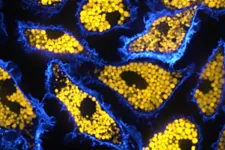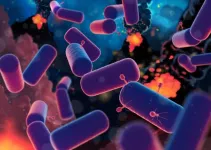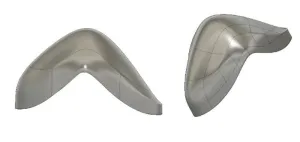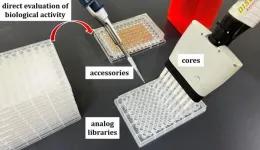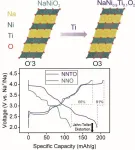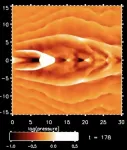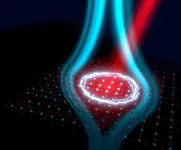(Press-News.org) Researchers at The Hospital for Sick Children (SickKids) have found that inflammation in an immune cell may be responsible in part for some severe symptoms in a group of rare genetic conditions called lysosomal storage diseases (LSDs).
LSDs affect about one in 7,700 live births worldwide. Children with the condition typically present at a young age with progressive neurodegeneration. Many children with LSDs die prematurely, and current treatments focus on symptom management.
Until now, the role of macrophages in the immune system and LSDs was not well known, but new research published in Nature Cell Biology led by Drs. Spencer Freeman, a Scientist in the Cell Biology program, Ruiqi Cai, a senior postdoctoral fellow and the first author of the study, and Ori Scott, a Transition Clinician Scientist in the Cell Biology program and a Staff Physician in the Division of Immunology & Allergy, identified that macrophage inflammation may contribute to LSD symptoms.
Macrophage cells take in and digest a large amount of nutrients to aid in the regular function of the immune system. To break down and recycle these nutrients, the cells rely on tiny organelles called lysosomes. When functional, a lysosome can break down large sugars into small sugars, which are then used as an energy source. In LSDs, these macrophage lysosomes become swollen and filled with waste.
On the publication of these findings, Freeman, Cai and Scott share how LSDs affect the immune system and how reducing inflammation could potentially improve or prevent symptoms in children with LSDs.
What is different about macrophages in patients with LSDs?
In LSD macrophages, swollen lysosomes try to avoid bursting open and spilling their contents – which would cause the cell to die. To do this, lysosomes open a channel that moves sodium out of the lysosomes, followed by water, to keep them smaller. This creates a message: the lysosome and the cell are stressed.
The stressed macrophages then send out an “SOS” signal by releasing a substance called MCP-1 (monocyte chemoattractant protein 1) that tells other macrophages: “please come and help.” As a result, many more macrophages move into the tissue. When there are too many macrophages in a tissue, and they all secrete MCP-1, this can cause inflammation and damage to the tissue.
How might your findings help patients with LSDs?
Our findings suggest that blocking the sodium channel or the MCP-1 receptor in macrophages could reduce the inflammation and tissue damage in LSDs. There are already drugs that target these molecules, some of which are used for other inflammatory conditions such as rheumatoid arthritis. We are planning to test these drugs in pre-clinical models, and hopefully translate the results to clinical trials for patients with LSDs.
By studying what causes severe symptoms in children with LSDs, we may identify better treatments for patients affected by these devastating conditions.
What are the next steps for your research?
We are continuing to explore how the lysosome regulates macrophage function and inflammation in LSDs and other conditions including neurodegenerative diseases. We hope that by understanding the molecular mechanisms of lysosome dysfunction and inflammation we can identify novel targets for drug development and improve the quality of life of patients with LSDs and other related conditions, like Parkinson’s disease.
When we study individuals with rare paediatric conditions, the benefits reach beyond these individuals and their families and extend to everyone by improving our knowledge of the complexities of human biology.
This research was funded by the Canadian Institutes of Health Research (CIHR), the German Research Foundation, the Hightech Agenda Bavaria, the European Research Council and Toronto Metropolitan University.
END
Cellular inflammation uncovered in rare neurodegenerative condition
2024-07-12
ELSE PRESS RELEASES FROM THIS DATE:
Insight into one of life’s earliest ancestors revealed in new study
2024-07-12
An international team of researchers led by the University of Bristol has shed light on Earth’s earliest ecosystem, showing that within a few hundred million years of planetary formation, life on Earth was already flourishing.
Everything alive today derives from a single common ancestor known affectionately as LUCA (Last Universal Common Ancestor).
LUCA is the hypothesized common ancestor from which all modern cellular life, from single celled organisms like bacteria to the gigantic redwood trees (as well as us humans) descend. LUCA represents the root ...
Real-life ‘stillsuit’: Dune-inspired upgrade for spacesuits allow astronauts to recycle urine into water
2024-07-12
Astronauts on spacewalks famously have to relieve themselves inside their spacesuits. Not only is this uncomfortable for the wearer and unhygienic, it is also wasteful, as – unlike wastewater on board the International Space Station (ISS) – the water in urine from spacewalks is not recycled.
A solution for these challenges would be full-body ‘stillsuits’ like those in the blockbuster Dune franchise, which absorbed and purified water lost through sweating and urination, and recycled it into drinkable water. Now, this sci-fi ...
A comprehensive derivative synthesis method for development of new antimicrobial drugs
2024-07-12
A method to screen a wide variety of drug candidates without laborious purification steps could advance the fight against drug-resistant bacteria.
Efforts to combat the increasing threat of drug-resistant bacteria are being assisted by a new approach for streamlining the search for antimicrobial drug candidates, pioneered by researchers at Hokkaido University, led by Assistant Professor Kazuki Yamamoto and Professor Satoshi Ichikawa of the Faculty of Pharmaceutical Sciences. Their methods, developed together with researchers elsewhere in Japan and in the USA, are discussed ...
Improving cycling performance of sodium-ion batteries through titanium substitution
2024-07-12
Researchers at Karlsruhe Institute of Technology (KIT) have made significant advances in sodium-ion battery (SIB) technology by improving cycling performance of the NaNiO2 cathode. They successfully synthesized, for the first time, the cathode active material NaNi0.9Ti0.1O2, which delivers a specific capacity of 190 mAh/g, thus positioning it as a potential candidate for application in high-energy-density SIBs. This innovative approach not only improves battery stability but also propels us toward advanced energy-storage solutions beyond.
With its high theoretical ...
Hatcheries can boost wild salmon numbers but reduce diversity
2024-07-12
The ability of salmon hatcheries to increase wild salmon abundance may come at the cost of reduced diversity among wild salmon, according to a new University of Alaska Fairbanks–led study.
The number of juvenile salmon released into the North Pacific Ocean by hatcheries increased rapidly in the second half of the last century and remains at over 5 billion each year. Salmon hatcheries have helped push annual pink salmon harvests in Prince William Sound from about 4 million fish prior to hatchery programs to roughly 50 million in recent years.
Using data collected from pink salmon streams ...
Artificial intelligence speeds up heart scans, saving doctors’ time, and could lead to better treatment for heart conditions
2024-07-12
Researchers created a computer model that uses AI to examine heart images from magnetic resonance imaging (MRI)
Results were comparable to those worked out by doctors manually, but instead of taking 45 minutes or more, the AI model takes just a few seconds
The AI model could lead to more efficient diagnoses, better treatment decisions and improved outcomes for patients
Researchers have developed a groundbreaking method for analysing heart MRI scans with the help of artificial ...
How the 'heart and lungs' of a galaxy extend its life
2024-07-12
Galaxies avoid an early death because they have a "heart and lungs" which effectively regulate their "breathing" and prevent them growing out of control, a new study suggests.
If they didn't, the Universe would have aged much faster than it has and all we would see today is huge "zombie" galaxies teeming with dead and dying stars.
That’s according to a new study published in the Monthly Notices of the Royal Astronomical Society, which investigates one of the great mysteries of the Universe – why galaxies are not ...
Light-induced Meissner effect in optically driven YBa2Cu3O6.48
2024-07-12
Superconductivity is a fascinating phenomenon, which allows a material to sustain an electrical current without any loss. This collective quantum behavior of matter only appears in certain conductors at temperatures far below ambient.
A number of modern studies have investigated this behavior in so-called non-equilibrium states, that is in situations in which the material is pushed away from thermal equilibrium. In these conditions, it appears that at least some of the features of superconductivity can be recreated even at ambient temperatures. Such non-equilibrium high temperature superconductivity, shown to exist under irradiation ...
Study finds short and long sleep duration associated with blood vessel damage in those recently diagnosed with type 2 diabetes
2024-07-12
New research to be presented at this year’s Annual Meeting of the European Association for the Study of Diabetes (EASD) (Madrid, 9-13 September) shows that people recently diagnosed with diabetes who experience short or long sleep duration are more likely to experience microvascular disease (damage to the small blood vessels), which could ultimately lead to more serious complications. The study is by Mette Johansen and Thomas Olesen, Steno Diabetes Center Odense, Odense University Hospital, Odense, Denmark, and colleagues.
Microvascular complications, such as retinopathy and nephropathy, are major contributors ...
IoT sensors tattle on stores that neglect promo displays
2024-07-11
Whether it’s a pharmacy, a supermarket, or a clothier, when you walk into a retail store in the U.S., you are sure to encounter a flashy promotional display featuring products from a specific brand.
It’s a marketing strategy that’s been proved to be highly effective at boosting sales. Brands carefully plan display campaigns, signing contracts with retailers that specify when to install the exhibits and for how long. They often provide financial incentives to encourage compliance.
But a new study from Ashish ...
